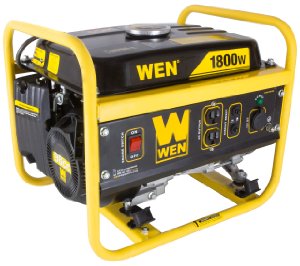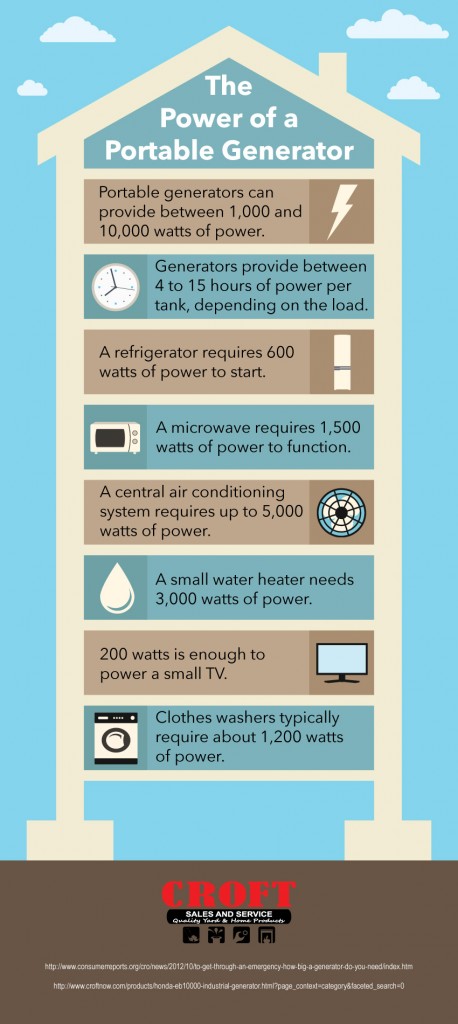Generators are now seen as a vital component in homes. Anytime a natural disaster hits like a hurricane or tornado, the usual consequence is a power outage. Generators are incredibly useful in these times, they are also used in case of any other unexpected outages as well. However, due to the high cost of a stationary standby generator many people choose to purchase a portable one, which is usually good enough for most power needs.
Portable generators are a useful power solution for the home and they can also be moved around away from the home. The power they generate can light up the household and its appliances while also powering power tools, such as air compressors and drills at construction sites. When you are away camping they can power lights or any outdoor-related power needs, as well.
Rating
Generators have two types of watt ratings, they are:
- Rated / running watts: This represents the ongoing watts for equipment to work.
- Surge watts: This represents the amount of watts needed for initial startup, usually for tools and appliances that have an electric motor. The surge watts for an appliance could be twice or thrice as high as its running watts.
What To Consider Before Buying a Portable Generator
Power requirements
This is the most important factor, it helps determine what the power needs are and consists of 3 parts:
- Determine the rated / running wattage: When an outage occurs not every appliance in the house needs powering. Make a list to determine the essential equipment that needs power, this could be medical equipment, the refrigerator, or vital electronics and computers. If the portable generator is for recreational use like when camping, think of cooking and lighting appliances.
- Determine the surge wattage: This enables you to ensure that all your appliances will start when an outage occurs. The surge and running watt requirements are indicated in the owners manual of the appliances.
- Calculate the total wattage: Add all the rated wattage of the appliances needed to be powered, this will give the total rated wattage. Check which equipment requires the highest surge wattage as determined from below.
Total watts = Total rated watts + highest surge watts.
List of common items in a household that require a high wattage:
- Stove
- Air Conditioner
- Dryer
- Heat Pump
- Hot Tub
- Water Heater
- Refrigerator
Type of Fuel
The type of fuel used is another major factor to consider, as the model of the portable generator will determine the fuel it uses. Some are even able to run on more than one type of fuel. A generator can run on:
- Gasoline: This is the most common and readily available fuel source. However, it doesn’t have a long shelf life, only about 6 months, and is usually stored in small tanks. Generators using gasoline are the cheapest to buy. Unfortunately, they are never intended for long-term, or emergency needs. This is because it is hard to store due to its highly inflammable fumes. Regulations allow storage of up to 25 gallons, which can be consumed within a 24 hour period. Generators operating on this fuel are mostly used for non-emergency operations.
- Liquid propane (LP): This fuel burns cleanly and has a long shelf life, and can be stored for 2 years. It is usually stored in larger tanks. This is the best option for disaster preparedness.
- Diesel: Doesn’t deteriorate as fast as gasoline over time. Generators that use diesel are the most efficient and reliable hence the most expensive. This is the best option for a durable generator mostly for commercial uses.
- Natural gas: Offers an unlimited gas supply to generators but are expensive and rare. This is because of the need for professional installation, which then hampers portability.
| Fuel Type | Long Fuel Life | Clean Burning | Cost Effective | Portable | Easy to Use/Set Up |
|---|---|---|---|---|---|
| Gasoline | X | X | X | ||
| Liquid Propane | X | X | X | X | X |
| DieseL | X | X | X | ||
| Natural Gas | X | X |
Other Considerations
Budget: Portable generators come in various types and sizes, the budget of an individual will determine the price range of generators available.
Features: Depending on the type of requirements needed, these generators come with a whole lot of features for ease of use or safety. Decide on which elements are necessary before purchasing one.
Additional accessories and services: Consider the warranty that comes with the generator, this will be beneficial once any problem arises or simply for maintenance purposes. Accessories such as a wheel kit, power cord, or a cover to protect it from dust, rain or snow are important to have as well. Find out about installation requirements, whether the service is included or how much more will it cost.
Body type: Materials used to build the generator will determine how it fares against the effects of corrosion. Use of aluminum or galvanized steel is the best option.
Types of outlets available: Not all portable generators have the same number and type of outlets. Find the one that has all that you need. Having outlets such as the 12V outlets are useful for charging batteries of cell phones and other low-load equipment.
Transfer switch: This is an important cable that prevents household equipment from being destroyed or damage to occur to the generator. It transfers power from the portable generator to the circuit panel in the house safely disconnecting the house from the utility grid. To connect or disconnect the house to and from the generator power, all that is needed is the flip of a switch.
Noise levels: Presence of noise restrictions in a neighborhood would mean checking on the decibel level of the generator. It will generally mean how far from the house the generator will be. Generators generally make a lot of noise, having one with a muffler reduces the noise significantly to acceptable levels. Smaller sized generators also tend to produce lower levels of noise.
The size of the fuel tank: The size of fuel tank matters since it will determine how long the generator will operate before refueling. Get a large tank for extra running time or use a propane generator which usually has big tanks.
Generator Features
Generators have many different features dependent upon the type and cost. Here are some features which are good to have.
Weather protected control panel: This offers protection against rain, dust, and dirt.
Circuit breakers: They are used to prevent overloading or extra current from flowing through. They cut the power protecting the equipment from damage.
Alternator: Provides an increased surge wattage, which is key for appliances that need a high wattage.
Wheels: If the generator is needed for sites where it must be moved around. Get one with wheels for easy movement and transportation. For construction sites with rugged terrain, go for portable generators with pneumatic wheels. The wheel kits of some generators are sold as a separate add-on as well.
Automatic Safety Shutdown: This function enables generators to shut down automatically when they sense an unsafe operating condition, such as high temperature, low oil pressure, or low oil level.
Electric start: Portable generators have two type of start: electric operated as a push-button or a pull-start / recoil to start the engine. An electric start is generally better, however; if the battery needs a recharge you might be stuck. Generators with an electric start and a pull-start as a backup are ideal.
Removable console: The console can be removable to allow the connection of appliances to the generator instead of using extension cords that must extend from the home to the outside.
Automatic idle control: This causes the engine to idle when it is not in use making for good fuel efficiency hence increasing the run time.
Manual fuel switch: This is a feature to shut off fuel manually and prevent leaks. It prevents fuel from being trapped in the fuel system and getting spoiled when stored. Once pressed when the generator is running, the engine will quickly run out of gas, burning all gas in its system.
Fuel gauge: This is a vital component that shows the level of fuel in the generator while it is running. This will allow the sourcing of extra fuel.
Type of Generators
Depending on how they are used, portable generators essentially come in four different types:
Recreational Generators
These basically refer to the generators used for outdoor events, such as camping. They are the inverter type generators. These are high-tech generators that operate silently, are efficient, and small in size. They are the only type that can be used in some campsites. These generators are also the cheapest, and have the lowest wattage. Additionally, they primarily have small tanks that use gasoline and have a watt range of between 800 – 12,000 watts.
Emergency Generators
These are the kind of generators found in homes that power household appliances. They are larger than the recreational generators and serve as emergency power during outages. They have larger tanks for longer usage and use both gasoline and LP fuel. These generators have a range of about 1,000 – 17,000 watts.
Semi-Professional Generators
These are the higher end generators for home and job use. They are good for homeowners who have higher power needs, and are good for powering a contractor’s power tools. Their engines are of high-quality and with a range of 3,000 – 10, 000 watts. They may come with built-in welders for welding capabilities as well as power for lighting and for other tools.
Professional Generators
These professional grade generators are built for commercial use. They have durable components and can run throughout the day on a daily basis. They are expensive and come with additional features for the busy professional. They have the highest wattage giving between 10,000 – 15,000 watts.
Top Brands of Portable Generators
Comparison Chart for Inverter Generators
| Generator | Running Watts | Fuel | Weight (lbs) | Dimensions(inches) | Noise Level (at 1/4 load) |
|---|---|---|---|---|---|
| Honda EU2000I | 1600 | Gasoline | 46 | 11.4×20.13×16.75 | 53dB |
| Westinghouse WH2000iXLT | 1800 | Gasoline | 43 | 17.8×20.3×12.5 | 51.5dB |
| Yamaha EF2000iS | 1600 | Gasoline | 44 | 17.9×19.3×11 | 52dB |
| Generac 6719 | 2000 | Gasoline | 52 | 18x12x22 | N/A |
Best Inverter Generator
Honda EU2000I
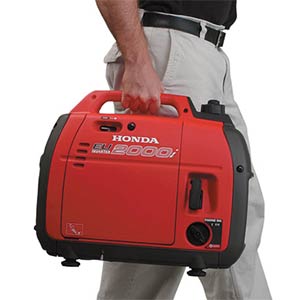
Built by Japan’s Honda company, the Honda EU2000I is the best inverter generator available. It is powered by Honda’s GX100 engine and is a powerful and compact generator. At only 46 pounds, it has a fuel tank capacity of 0.95 gallons and is fuel efficient; known to operate for around 8 hours at full tank. This small generator is fitted with the Honda Oil Alert a system that switches the generator off when the oil level is low.
Circuit protection is also inbuilt to prevent overloading while in operation. It is started using a pull-start system that it easy to use. For extra power, it can be used with another similar generator to give double the power. Be careful about DC charging since it is not regulated. It is extremely quiet and one can hold a conversation when it is close by.
To show how reliable the Honda EU2000I is, the manufacturer gives a 3-year warranty for both residential and commercial use when purchased from an authorized dealer. This confirms that it is a high-quality product. It has consistently been regarded as the best inverter generator. For low power needs grab it, as it’s the best inverter generator available.
Comparison Chart for 5,000 Watt Generators
| Generator | CARB Compliant | Price | Running Watts | Fuel | Weight (lbs) | Dimensions (LxwxH) | Run Time (@ 50% Load) |
|---|---|---|---|---|---|---|---|
| WEN 5655 | Yes | $603.33 | 5000 | Gasoline | 182.5 | 21×28.5×22 | 11 hrs |
| Generac 5939 | No | $620.10 | 5500 | Gasoline | 180 | 25×28.75×26.75 | 10 hrs |
| Westinghouse WH5500 | No | $762.96 | 5500 | Gasoline | 168 | 22x27x20.5 | 14 hrs |
| Champion Powe Equipment 41135 | YEs | $617.65 | 5500 | Gasoline | 182 | 22×31.3×20.9 | 11 hrs |
Best 5,000 Watt Generator
WEN 5661
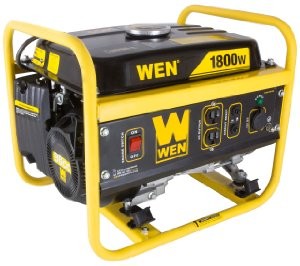
The WEN 5661 is an impressive generator that has 5,000 running watts and 5,500 surge watts. It has a fuel tank that has a capacity of 6.5 gallons and when at half load, it delivers around 11 hours of runtime. It comes loaded with the following additions:
- Four 120V three-prong receptacles.
- A twist-lock 120/240V receptacle.
- A 12V DC outlet that is similar to a car charger.
- Spark arrestor.
It comes with a 2-year warranty and has a large network of approved technicians to assist when the generator develops problems. Inbuilt is a circuit breaker and an automatic voltage regulator to prevent power surges and protect the equipment. For easy care, a digital counter counts the run time hours to assist in keeping a maintenance schedule. It also has a low-oil protector that shuts down the generator to prevent damage.
To easily determine if power is on, there is a power indicator light located above the receptacles. For support, the WEN has two rubber mounts and wheels for portability. It conforms with EPA requirements while also meeting the USDA Forest Service standards making it approved for use in U.S. National Forests. It is also CARB compliant and thus can be sold in California.
Comparison Chart for 10,000 Watt Generators
| Generator | CARB Compliant | Price | Staring Watts | Fuel | Weight (lbs) | Dimensions (LxwxH) | Run Time (@ 50% Load) |
|---|---|---|---|---|---|---|---|
| Powerland PD10000E | Yes | $980 | 10000 | Gasoline | 230 | 40x29x27.5 | 12 hrs |
| Generac 5747 | No | $1369 | 10000 | Gasoline | 250 | 28×31.5×26.75 | 10 hrs |
| DuroMax XP10000EH | No | $1289.99 | 10000 | Dual (Propane and Gasoline) | 265 | 27x34x27 | N/A |
| All Power America APGG 10000 | N/A | $749.99 | 10000 | Gasoline | 232 | 21.25×31.3×25.2 | 11 hrs |
Best 10,000 Watt Generator
DuroMax XP10000EH
The DuroMax XP10000EH is a hardy, durable generator that is built with a cast iron and steel case. It has a running wattage of 8000 and starting wattage of 10,000. With its large size and engine, the DuroMax isn’t that noisy when operational. This is due to its quiet exhaust muffler making it measure only 72dB at 7 meters.
It has a dual fuel system that can use both gasoline and liquid propane. This means it offers a greater run time for appliances and equipment. Using propane doesn’t harm the generator’s carburetor and just requires a couple of seconds to switch from one to the other. Using the DuroMax allows the use of all sizes of propane tanks. If it doesn’t start due to less pressure from the cylinder, simply start it with gasoline for a couple of minutes then switch to propane.
To cater for a reliable performance the DuroMax has an electric key to start it; this functions like a starting a car. If the battery isn’t charged, there is a pull-start to prevent it from being stuck. To make it portable, it has solid-filled tires that can’t go flat making it perfect for any kind of terrain.
The DuroMax features a massive 18 HP engine, this makes handling heavy electrical loads a breeze while powering lower load appliances. It comes with a one-year warranty and is fully operational once it is delivered.
The power panel has all the bells and whistles needed for an impressive generator as this. It houses all the configurable components, oil warning light, volt meter, power outlets, and the start switch.
Generator Safety
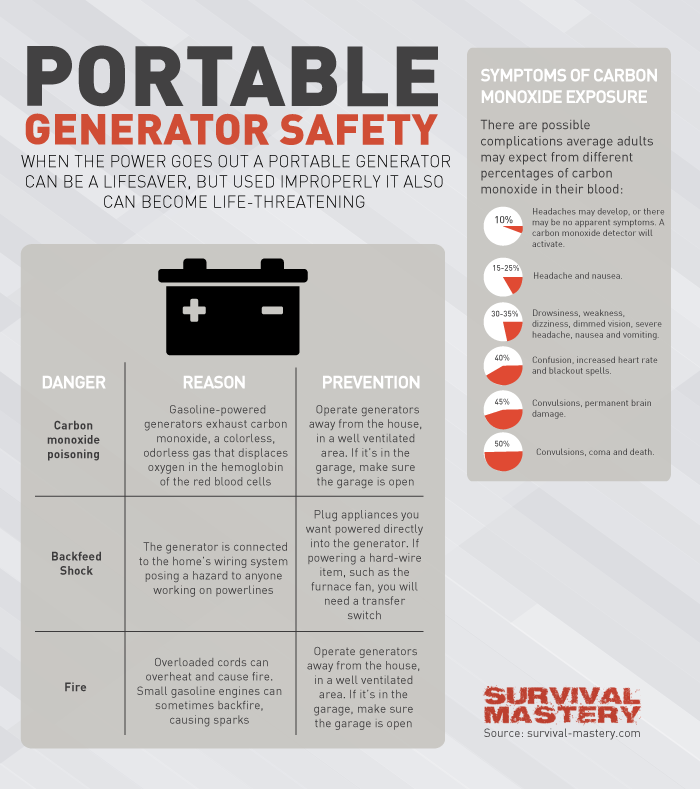
Infograph courtesy of survival-mastery.com
Generators can be dangerous if their safety requirements aren’t adhered to. Here are some safety tips to ensure that the generator serves its purpose without causing any harm. Check the operating manual for more safety instructions and warnings.
Grounding: A generator should always be properly grounded; this will prevent electrocution
Ventilation: Exhaust from generators has carbon monoxide, which is an odorless and poisonous gas. This means that a generator can only be run outdoors where there is adequate ventilation. Never run it indoors or in a garage, these areas don’t have the required ventilation even if the doors and windows are open.
Fueling: Fuel is very flammable and can explode leading to severe burns or worse. Do not smoke or light fires close to the generator. Do not add fuel to a generator that is running or hot, switch it off and wait for it to cool.
Don’t overfill the fuel tank, because fuel expands when hot and may overflow to the engine causing a fire to erupt. After turning off the generator, keep away to avoid burns since most of its parts are very hot.
Wiring: Do not connect a generator directly to your house’s wiring. This may cause a back-feed, which is power traveling back onto the power grid. It could cause injury to utility workers who are working to restore power. Do not start or stop the generator with electric equipment plugged in. Overloading the generator by operating more appliances than it can handle can also cause harm to your equipment.
Use the right kind of power cords, and only heavy-duty outdoor cords should be used with the correct load. Overloading them can result in damage or fire. Those that are worn or have exposed wires should not be used.
Operation: Shield the generator from the weather elements, and do not operate in snow or wet conditions without a shade. Operate the generator on a level surface and allow for enough clearance on every side when operational. Carry out inspections regularly and test the generator for readiness. If in need of repair, consult a dealer. When transporting or setting it up, disconnect the spark plug from its wire to prevent it from accidentally starting.
Conclusion
Portable generators are great devices that can rescue someone when faced with a power outage. They are easy to use and fuel efficient, providing clean power. The fact that they can be easily transported to and fro especially when doing outdoor activities is why they are beloved by so many. Use the above information to make a choice for your supplementary power needs. For more guides on which portable generator to buy,check here.
Always ensure that the proper safety, operating, and maintenance procedures are adhered to, this will prevent unnecessary harm or damage to equipment and property. Do not connect a generator to the house wiring yourself, seek professional help to ensure an approved power switch is installed and is in compliance with all the electrical codes.

